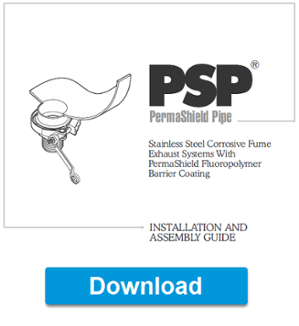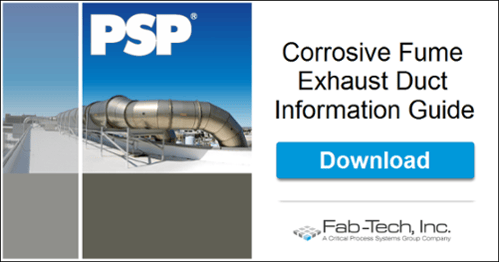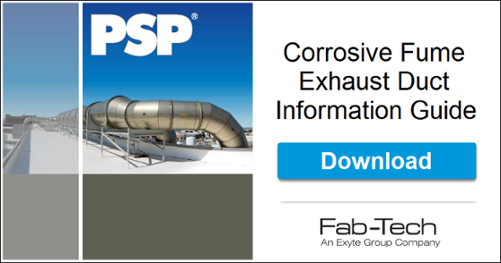/Saddle%20tap%20installed%20on%20PSP%20coated%20vent%20pipe.png?width=233&name=Saddle%20tap%20installed%20on%20PSP%20coated%20vent%20pipe.png)
Hot Tap Installation Without A Pressurized Glove Box
As process systems and facilities grow, there usually comes a time when new fume exhaust components need to be added to existing vent duct configurations.
For most facilities, it can be extremely costly and disruptive to take systems offline in order to make such upgrades. Fortunately, PSP® exhaust duct systems are capable of remaining in-service (hot) while saddle tap installation procedures are performed.
The instructional below focuses specifically on how to perform a hot tap installation on PSP® fume exhaust duct without the use of a glove box. For hot tap installations using a pressurized glove box, please follow this link.
This article lists the tools you'll need, some important tips, and detailed steps to guide you through the process.
Tools Required:
- Center Punch
- Marking Pen
- Power Shear
- Calibrated Torque Wrench
- Flat File
- Lint Free Cloth
It's recommended that two people are available to perform this installation depending on the size of the fitting and the location of the branch line at the host duct. Make sure that all of the required material is available at the work location before starting the project.
/Saddle%20Tap%20Configuration.png) Figure 25. Saddle Hardware and Configuration
Figure 25. Saddle Hardware and Configuration
Procedure:
1) Cut Opening
Trace the provided template onto the host duct. Use a center punch to mark the pilot holes which are drilled on each corner of the template. Drill larger holes in each corner to accommodate the power shear. Cut an opening in the host duct and carefully file the edges of the cut.
In order to preserve air pressure in the system, cut a thin sheet of galvanized steel 2” larger than the dimension of the template and place over the hole.
2) Install Interior Saddle
Apply PTFE gasket to the outside edge of the interior saddle, as shown below. Slip the interior saddle carefully into the opening. With the saddle in place, insert studs finger-tight into the two horizontal center holes.
/Interior%20and%20exterior%20saddles.png)
Figure 26. Interior and Exterior Saddles
3) Install Exterior Frame
Set the exterior frame over the tap, locating the slots over the two exposed centering studs. Place flat washer, lock washer and nut onto each center stud, and lightly tighten. This will position the saddle tap temporarily in place.
4) Position Tap

Install studs along the bottom horizontal edge of the interior saddle. Finger tighten. Re-position the saddle by gently pulling down on the tap until the bottom studs contact the raw edge of the host duct opening. Now tighten the horizontal center nuts to draw the saddle halves together.
5) Install Hardware
Install studs in all remaining holes of the interior saddle. Tighten with fingers. Visually inspect that the saddle is in proper position and that the gasket can make full contact with the interior of the host duct. Place flat washer, lock washer and nut onto each of the studs, lightly tighten.
6) Torque Nuts
Using a calibrated torque wrench, tighten the two center horizontal nuts to recommended torque specifications (8 ft lbs minimum for 5/16” bolts, 5 ft lbs minimum for 3/8” bolts). Torque in at least 3 stages until specified torque is reached. Continue tightening all the other nuts to recommended specifications, moving evenly away from the center nuts to prevent distortion of the saddle against the host duct. On larger duct, tighten from the center of all four sides of the saddle. Leave the corner studs as the last ones to tighten. The tap is now ready for use.
/PSP%20and%20PSP-EZ%20saddle%20taps.png?width=556&height=289&name=PSP%20and%20PSP-EZ%20saddle%20taps.png) Figure 27. PSP® and PSP-EZ™ Saddles
Figure 27. PSP® and PSP-EZ™ Saddles
ADDITIONAL Information
If you are looking to connect to an existing non-PSP® fume exhaust duct system, specialty adapters and joint accessories are available for this purpose. Fab-Tech's specialty adapters allow the joining of PSP® duct to a wide range of threaded or other flanged piping systems. Adapters are available for male or female NPT threaded pipe, KF flange pipe, and Swagelok® tubing.
If you would like more information about PSP® corrosive fume vent pipe and duct, please feel free to download our general information guide below:
OR
View Our Glove Box Hot Tap Installation Guide Here

